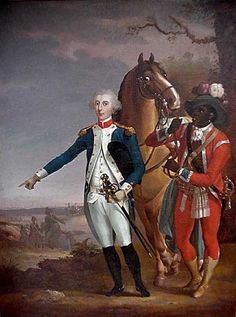 |
| The Marquis de Lafayette at Yorktown by Jean-Baptiste Le Paon 1782, oil on canvas |
The Grolier Club takes a giant step forward in history to focus Lafayette's sustained efforts in France, the United States, and South America on behalf of the abolition of slavery. The exhibition, THE MARQUIS de LAFAYETTE, A TRUE FRIEND OF THE CAUSE: Lafayette and the Antislavery Movement is on view through February 4, 2017 with free lunchtime tours from 1-2 pm on December 14, January 11 and 18, and February 1, and are conducted by curators Olga Anna Duhl and Diane Windham Shaw. No registration is required, free admission. Where: 47 East 60th Street
JUST WHO WAS THE MARQUIS TO GAIN SUCH NOTORIETY? Although the Marquis de Lafayette (1757-1834) fought in the American War of Independence, he was a friend of the Native Americans, defended the rights of French Protestants and Jews during the French Revolution, supported the emancipation movement of people of Poland, Ireland, Italy, Greece and South America, and promoted the ideas and causes of women. Most significantly, he remained throughout his life a fervent advocate of the abolition of slavery and the African slave trade, earning the recognition of prominent British abolition is, Thomas Clarkson, as "a true friend of the cause."
THE EXHIBITION AT LARGE: This is an exhibition not to be missed for its historical record traces Lafayette's first ideals of liberty and equality. Early on Lafayette learned that the revolutionary era hardly benefited all members of society. In fact, one of the most daunting paradoxes of that era, which became a source of reflection and action for him, was between the national independence of the newly formed United States and the practice of slavery and the slave trade. His first encounter with slaves was on the South Carolina coast.
Highlights of his role in service with the Continental Army are revealed in letters to his mentor, George Washington, written from Valley Forge, Newport and Virginia during the Yorktown Campaign, where Lafayette writes of the intelligence gathered by one of his spies, James, an enslaved African American. On view are many original artifacts including a highly significant letter written by Lafayette to Washington requesting his partnership in a venture to free slaves.
Lafayette's complicated story includes his membership in the French Society of the Friends of Blacks. On view are Publications of the Society as well as stunning French prints of the American Revolution as well as the decree abolishing slavery in the French colonies.
Ta Ta darlings!!! Lafayette is in town for a short sojourn. Drawn from Lafayette College's rich collections of 18th and 19th century rare books, manuscripts, prints and objects, some of which are on public view for the firs time, the approximately 130 works in the exhibition also include loans from Cornell University and the New York Historical Society. FAN MAIL ALWAYS WELCOME at pollytalknyc@gmail.com. Visit Polly's other Blogs at www.pollytalk.com on fashion, visionary men, women determined to succeed and poetry.



